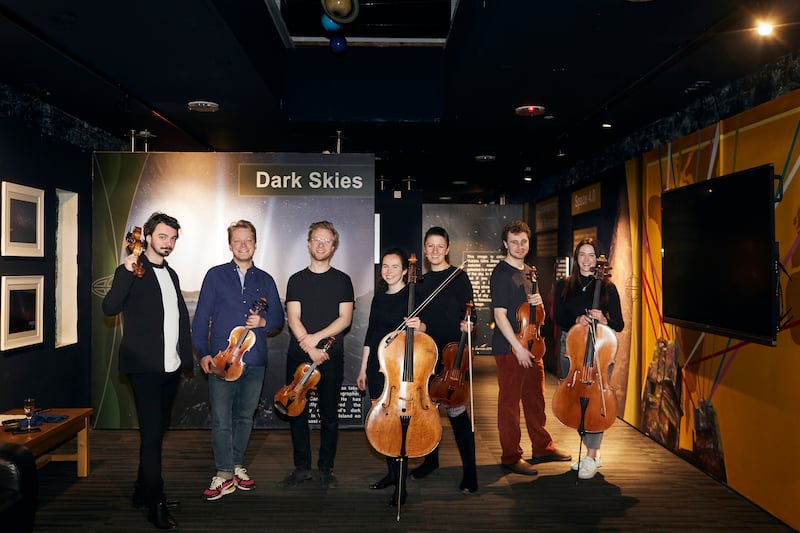Ortús Chamber Music Festival is the brainchild of two friends, the violinist Mairéad Hickey and the cellist Sinéad O’Halloran. Back in March 2016, when the first festival took place, the slogan was “Bringing home some of Ireland’s finest young musicians”, and the Ortús website carried an endorsement from the former president Mary McAleese.
Hickey and O’Halloran are from Cork, and from the start the festival presented its concerts not just in Cork city but also as far away as in Youghal, in the eastern corner of the county. Ortús seems to have emerged stronger and larger from the pandemic. This year’s offering, with O’Halloran the sole curator, was the biggest yet. Staged over the eight days between Sunday, February 26th, and Sunday, March 5th, it ran to eight concerts in eight spaces, including an outlier in Bantry, and a programme by student ensembles taking part in an outreach programme.
The festival might best be described as following the idea that where there’s a will there’s a way. Why else would you even think of trying to put a concert on in Blackrock Castle Observatory, a multiply repurposed fort that is now a visitor attraction without anything approaching the kind of space needed for a regular, seated classical concert? And for an audience capped at just 50 people?
The theme for the observatory programme was moonlight, and the presentation was cushion style, although there were some chairs. The evening opened with an arrangement for string sextet of the opening movement of Beethoven’s Moonlight Sonata played by members of the Marmen Quartet (which O’Halloran joined last year), with the violinist Eoin Ducrot, the viola player Fiachra de hÓra and the cellist Peggy Nolan.
Transforming a piece that’s based on slow piano arpeggios, held in a kind of stasis below an even slower-moving melody, into a work for strings is not a straightforward proposition. The effect on this occasion was to create the feeling of too much intervention, too much internal movement. It may well be that the unforgiving closeness between performers and listeners was the cause. The blending effect of a more woolly acoustic might have made everything sound right. The performance was given in the round, so other people may have had very different experiences.
The viola player and teacher Paul Coletti’s Moonlight Journey for two violas (the Marmen’s Bryony Gibson-Cornish with de hÓra) embodies a memory of the Moonlight Sonata; it was performed with the players straddling two acoustic spaces. It’s the kind of piece I would expect to go down a treat at a viola conference, and it was delivered with a real sense of relish in its showcasing of rich viola sound.

The final work brought the Marmen Quartet into one of the castle towers for a performance of György Ligeti’s First String Quartet, subtitled Métamorphoses Nocturnes and written for the composer’s bottom drawer in the culturally repressive Budapest of 1953 and 1954. Bartók and Berg are declared influences, but the work is full of mechanisms that would be put to very different use in the composer’s later output, after he fled to Vienna following the Hungarian uprising of 1956. The Marmen embraced the music’s hard edges and delicacy as fully as its Bartókian flavours.
Their later offerings included Haydn’s String Quartet in C, Op 50 No 2, with their leader, Johannes Marmen, delivering rocket-like runs with exhilarating, machine-like precision in the Aula Maxima, at University College Cork. At St Peter’s on North Main Street, they played a group of Bach chorales, one of their daily rituals, in a manner that sucked out any sense of hymn-singing and replaced it with a masterclass in quartet tone, articulation and texture.
The unpredictability of their approach is perhaps the most predictable thing about them. They played Brahms’s Sextet in B flat, Op 18 (with de hÓra and Nolan at the Aula Maxima), Beethoven’s late Quartet in C sharp minor (at My Place, in Midleton) and Franck’s Piano Quintet in F minor (with the Welsh pianist Jâms Coleman in the Curtis Auditorium at Cork School of Music) in ways that suggested they had approached the music without preconceptions or concern for performance history. The success, it has to be said, was mixed, but the journeys were always highly stimulating.
Coleman made his first festival appearance in the challengingly chilly Sea Church in Ballycotton, where, for works by Schumann, Ailbhe McDonagh, Rebecca Clarke and Fauré, he was provided with an inappropriately short Yamaha grand piano.
He partnered the Marmen in Franck’s Piano Quintet (this time on a Steinway concert grand) and showed himself to be a real wizard in the dark art of shape-changing that this quintet demands of keyboard players. It was a highly charged performance, but he didn’t always seem to be doing the right thing at the right time, often disappearing into the background when he needed to be assertive. The audience loved the passion, but I missed a familiar sense of tonal substance.
The standout performance by Ducrot was a rigorously sculpted account of Bach’s Partita in D minor for solo violin (at St Peter’s). And de hÓra brought light relief in Garth Knox’s Quartet for One, a lockdown work from 2020 that has a lonely, frustrated but creative viola player creating a string quartet all by himself, onstage with four music stands and four chairs (at My Place). And the Marmen showed an unexpected (what else?) warmth and deep tonal richness in the New Zealand composer Salina Fisher’s cunningly paced Heal, a 2020 exploration of music and healing.





